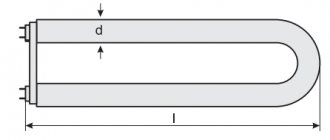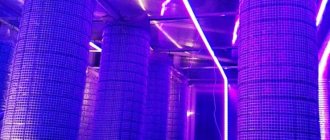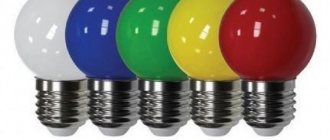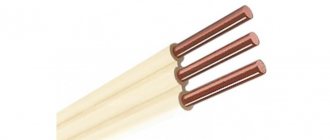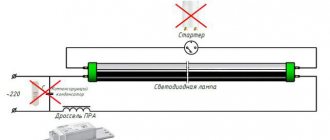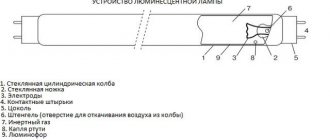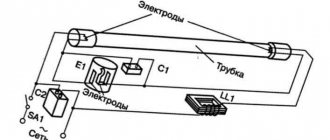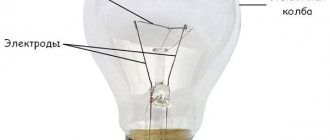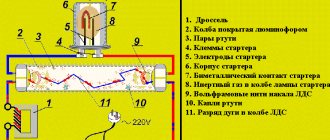Design features and principle of operation
Fluorescent lamp 36 W
A 36 W lamp is an ordinary glass tube, the ends of which are sealed. The inside of the flask is treated with a special agent - a phosphor, which converts the resulting ultraviolet radiation into visible light. The tube is also filled with a mixture of argon and mercury gases. First, all the air is pumped out of the pipe. The current passes through a tungsten helix, which is coated with oxides to increase reliability. Nickel electrodes are connected to the ends of the spiral.
In order for the light bulb to light up, you need to apply an electric current. It increases the temperature of the coil, which causes a discharge. The resulting ultraviolet passes through the phosphor and the walls of the flask and turns into visible radiation at the output.
Inside the flask there is a mixture of different gases and vapors, which is plasma. It emits a stream of light in the visible and invisible regions of the spectrum. The phosphor converts invisible radiation into visible radiation, and as a result, the lamp can illuminate a certain area.
Thanks to this design and improved materials, the light bulb will consume less electricity than conventional lamps. If compared with an incandescent lamp, the amount of energy required will decrease several times.
Fluorescent lamp device
Lamp device
The device is a long glass tube. The light bulb consists of several parts:
- An elongated narrow flask made of quartz glass. The inside is coated with a white phosphor, which makes the lamp look opaque. To enhance the quality of the light flux, there can be several layers of phosphor (3 or 5). The air is pumped out of the tube, instead argon and a drop of mercury are pumped in, the latter turns into steam with increasing temperature;
You may be interested in The problem of light bulbs burning out, how to fix it
A fluorescent lamp consists of several parts
Important! The pressure inside the bulb does not exceed 400 Pa, which is why they are called low-pressure lamps.
- 2 bases with output contacts. They are located on both sides of the tube and are connected to the mains;
- Electrodes: they are soldered at both ends of the bulb. They are spiral-twisted tungsten wires and are additionally coated with barium or strontium salt oxide to protect and increase service life. Hard nickel electrodes are mounted parallel to the tungsten electrodes. They are connected at one end to tungsten.
Also for connection you need a choke - a ballast, without which the lamps will not work. Its task is to ensure the stability of the current at its variable value.
The principle of operation is to pass a charge through mercury vapor
Types of fluorescent lamps
Any luminescent devices can be divided into two groups:
- General purpose lamps. These include lamps with power from 15 to 80 W.
- Special purpose. These include devices up to 15 W and over 80 W. They are called low-power and high-power, respectively.
General purpose lamps provide natural light.
Shapes of bulbs of compact fluorescent lamps
Devices can also be divided according to a number of technical indicators:
- According to light discharge: arc and smoldering.
- By radiation: with natural light, ultraviolet and different colors.
- According to the shape of the flask: linear tubes and curly models.
- Along the length of the tube.
- According to the base used: 14 mm and 27 mm.
- According to the distribution of light flux: directional and non-directional.
Types of illumination depending on the color temperature of light
Classification by color temperature:
- 2700-3400 K. These are warm shades. They have a calming and relaxing effect, which is why they are often placed in bedrooms.
- 3400-5600 K. Give natural radiation. Suitable for living rooms, kitchens and other types of rooms.
- 5600-6400 K. Cold tones. They increase tone and performance, which is why they are used in offices.
A 36 W luminescent source is analogous to a 40 W device. This is due to the fact that modern technologies allow the use of higher quality, reliable and modern materials.
Energy-saving devices use a high-quality phosphor layer and an improved design of the electrode block. Thanks to all these features, fluorescent light bulbs with lower wattage have a higher effective luminous flux. It is important to note that the tube diameter is reduced by 1.6 times.
Description of fluorescent lamps
Based on their spectral radiation, fluorescent lamps can be divided into two types:
- Standard use.
- Special application. For example, ultraviolet, antibacterial and others.
In standard flasks there is a single-layer phosphor
, thanks to which different shades of white light are obtained. Yellow light is considered warm, blue light is considered cold. It can be identified by the marking, where the first letter L is the fluorescent lamp, the second is the color, namely:
- LB – white;
- LD – daytime;
- LE – natural;
- LCB – cool white;
- LTB – warm white color.
The marking contains letters that indicate the color of the flask: K - red, G - blue; S – blue, Z – green. Ultraviolet devices are marked with the letters UV.
Light flow
Fluorescent lamps are measured in lumens (lm).
To improve the quality of color reflection
, to make the picture brighter and more saturated, a three or five-layer phosphor is used, which has a 12% or more improved luminous flux.
Standard lamps include general purpose lamps
, produce them with a power from 15 W to 80 W of different lengths and shapes, used for daylighting of warehouses, workshops and other premises that occupy large areas. Improved lamps are capable of more brightly transmitting the light gamut of surrounding colors; they have found their use in exhibition halls, art galleries, clothing stores, that is, everywhere where color shades should be perceived comfortably by the eye.
Special lamps have a specific type of phosphor
, which contains additives that can change its properties. They make it possible to select the desired spectrum of ultraviolet radiation depending on its purpose; for example, such a flask is successfully used in a bactericidal medical device that is capable of destroying bacteria and disinfecting the air.
For the same purpose, these lamps are used in grocery stores, where it is necessary to protect products, as well as in factories for sterilizing containers. Special flasks are also produced that give different spectral frequencies. They are widely used in billboards as well as in show business.
Technical characteristics of the lamp LB 36
Fluorescent lamps LB 36 Watt are connected to the AC power network together with starting control equipment and have the following characteristics:
- G13 type base located at its ends;
- dimensions: flask diameter 26 mm, length: L1 – 1213.6 mm, L – 1199.4 mm;
- power 36 W;
- lamp voltage 103 V;
- luminous flux 2800 lm;
- service life 12000 hours.
They also differ from each other in the type of radiation, in the shape of the glass tube, which can be straight or curly, non-directed and directed light flux.
Design Features
A fluorescent lamp is a cylindrical glass tube, sealed at two ends, the inner surface of which is coated with a phosphor. The air is completely pumped out of it, and argon and a drop of mercury are added, which evaporates under the influence of temperature, taking on a gaseous form.
Electrodes made of tungsten wire spirals are soldered into both ends of the flask, which are coated with a protective layer of an alloy of strontium or barium salt oxide, which increases its service life. Hard nickel electrodes are mounted parallel to the spirals, which are connected to them at one end.
In order for the bulb to glow, an electric current must be supplied inside it. When heated, an electrical discharge is created, causing the appearance of ultraviolet radiation. A luminescent substance called phosphor absorbs it, releasing light of the desired spectrum.
Color rendition
The light temperature parameter of a fluorescent lamp is measured in kelvins; changing this value affects the color shade:
- in the range from 2700 to 3400 K - this is warm light;
- from 3400 to 5600 K – natural;
- from 5600 to 6400 K – cold color.
Light temperature affects human biorhythm. A cool color increases your ability to work; a warm color, on the contrary, relaxes you and makes you want to rest. That is why lamps with bulbs that produce cold light are installed in offices and industrial premises.
It is important to note that each manufacturer may have its own labeling. For example, the number 54 denotes a cold color, and 33 denotes a warm color.
Marking of light sources
Lamp markings
The 36 W fluorescent lamp has simple letter and number markings. For example, a 36w fluorescent lamp with the abbreviation LB-36 is deciphered as follows:
- L – lamp.
- B – white color.
- 36 – power, W.
There are also 36W fluorescent lamps with different markings:
- LTB. Warm white light. They have a barely noticeable pink tint.
- LD. Close to daylight.
- LDC – fluorescent lamps with different colors.
- LCB – cool white.
The given markings are used in Russian products. Foreign designation is different. It consists of three numbers and English words indicating the type of glow. Labeling may differ between different foreign manufacturers.
LB products are the most efficient in terms of output luminous flux compared to other devices of the same power.
Specifications
Characteristics of fluorescent lamps of the LB series
36 watt lamp has the following characteristics:
- radiation brightness 6-11 cd/sq.m;
- ripple factor 23%;
- brightness and power increases with increasing rated voltage;
- service life from 4800 hours, average value is 12000 hours;
- base G13;
- flask diameter 26 mm;
- length of most part 12 cm;
- rated voltage 103 V.
The data given are average values. They may vary between different manufacturers and under specific operating conditions. The service life can be significantly reduced due to frequent switching on and off or high room humidity and low temperature. Therefore, it is important to choose the right location for installing the light source.
Advantages and disadvantages
The main advantages of the product will be:
- high efficiency when compared with conventional lamps;
- very high efficiency. But they are worse than LED lamps, but they are expensive;
- increased color rendering, great for large rooms;
- long period of use. If you follow all the instructions, the work will last up to 40,000 hours;
- are not equipped with filaments, due to which the lamps quickly deteriorate;
- many types of fluorescent lamps are not subject to high heat and can be used in floor lamps, where the maximum permitted temperature is limited;
- the light spreads evenly brightly throughout the room.
Broken fluorescent lamp
Main disadvantages of the products:
- due to mercury, they need to be processed using special equipment;
- over time, the characteristics of the phosphor decrease and its efficiency decreases. As a result, the performance of the lamp decreases;
- you need to use ballasts, without it the lamp will not work.
Advantages and disadvantages
Fluorescent devices are inferior to LEDs, but are still often used for illumination. This is due to the positive qualities of a 36 W fluorescent light bulb:
- small dimensions and weight;
- wide scope of application;
- saving;
- large coverage area;
- extended spectrum of light;
- long service life;
- good efficiency;
- availability of analogues for various purposes and colors.
Light bulbs also have disadvantages:
- the presence of harmful substances in the device;
- difficulty of disposal;
- harm to human health and eyes;
- requires throttle to start;
- increase in cost;
- long startup;
- reduced service life due to frequent switching on and off.
The devices are actively used and replace outdated incandescent lamps and halogen devices.
Advantages and disadvantages
Fluorescent lamps have both advantages and disadvantages. We present some of them below.
The emitted spectrum is very wide, they produce diffused, soft light. In this case, it is possible to choose the most favorable shade for perception.
The service life is about 20 thousand hours. For example: an incandescent lamp lasts no more than 1 thousand hours.
Fluorescent lamps are a chemical hazard because they contain mercury. Their disposal is strictly regulated and is expensive.
The radiation spectrum, although wide, is uneven. The predominance of any harmonics in it causes color distortion.
The work is associated with the permanent process of igniting the gas mixture, which occurs at double the network frequencies (100 Hz) when using electromagnetic ballasts and low-quality, cheap electronic ballasts (it is found more often in lamps). This has a detrimental effect on human vision, and also does not allow the use of control devices - dimmers, motion sensors - in lighting systems. In the first case, because a decrease in the supply voltage causes arc failure. And in the second, a rapid failure of the lighting device occurs due to the burnout of the filament on the base.
Areas of application
Fluorescent lamps in an industrial workshop
Fluorescent lamps have a wide range of uses. They can create all types of lighting in residential premises, offices, fill industrial premises with light, and create illuminations.
The devices have also found their application in medicine. Using special fillers, bactericidal and ultraviolet lamps can be created. They are used to clean the room from bacteria and germs. Lamps can also be installed in shops, warehouses and enterprises for the purpose of disinfecting premises.
The ability to create sources of different colors has led to the use of fluorescent light bulbs in entertainment, show business, and advertising.
Recommendations for selection
Fluorescent lamps osram L 36W/60
Lamps are selected for a specific type of lamp. This obliges the buyer to pay attention to its characteristics. Particular care should be taken when choosing fluorescent lamps. For example, the Russian lamp LB 36 has a length of 1200 mm and is suitable for installation in a corresponding device. A 35 W device of similar power from the German company OSRAM has a different length - 1449 mm. The length of the tube must be taken into account when purchasing.
Attention is also paid to the diameter of the flask. The standard is 16 mm, but you can find devices for 12 mm, 25 mm and other sizes. The luminous flux directly depends on the diameter. In lamps you can use a tube with the same base (G13) with a smaller diameter, but not with a larger one.
Fluorescent lamps have pulsations, which have a negative impact on health. To reduce the negative impact, you should give preference to high-quality, expensive and proven devices purchased from a professional store. A lamp of unknown manufacture is made from low-quality components, and this directly affects the flickering.
